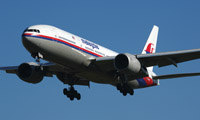News Backgrounder
Lessons learnt from MH 370 tragedy
As Orient Aviation went to press, the multi-nation search for a missing Malaysia Airlines B777-200, Flight MH 370, had dramatically shifted 1,100 kilometress north from its previously targetted location in the southern Indian Ocean. With no hope of finding the 239 passengers and crew onboard alive, rescue teams are concentrating on finding the lost aircraft and its “Black Box”.
April 1st 2014
On March 29, the Australian investigative agency, the Australian Transport Safety Bureau, said it had “new information based on continuing analysis of radar data between the South China Sea and the Strait of Malacca before radar contact was lost with the MH 370”. Read More »
 |
Until the Australian announcement of a search redirection, rescue efforts had been focused on one of the most remote areas of seas in the world, the southern Indian Ocean. For several days, rescue aircraft and ships from 26 nations had been combing the wind and storm ravaged seas where debris thought to belong to the missing airliner recently had been spotted, both visually and via satellite.
Several of the nations participating in the search are giving neighboring nations unprecedented access to their territorial waters as the urgency to locate the cockpit voice recorder and flight data recorder intensifies.
The astonishing story of MH 370 and its sudden disappearance from the world’s aviation radar network began at 1.19am on Saturday, March 8. As the Malaysia Airlines B777-200 was being handed over by Malaysian air traffic controllers to Vietnamese airspace on its way to Beijing, 27-year-old first officer, Fariq Abdul Hamid, calmly responded with “All right, good night”. It was the find communication between air traffic control and the flight deck of the MAS B777-200. The big Boeing jet literally vanished.
The last signal from the airline’s Aircraft Communications Addressing and Reporting System (ACARS) was received 12 minutes before the co-pilot’s final words, explained Malaysia Airlines chief executive, Ahmad Jauhari Yahya. The next ACARS signal should have been automatically broadcast 30 minutes later, but it never arrived. Someone in the cockpit not only turned off ACARS, but also disconnected two crucial communications systems and the aircraft’s Transponder.
It is now known the aircraft, which departed Kuala Lumpur with Captain Zaharie Ahmad Shah in the left hand seat, turned westward and soon afterwards headed south over the Indian Ocean.
“I think what’s clear is someone was in command of the plane who knew how to fly a 777,” said Association of Asia Pacific Airlines (AAPA) director general, Andrew Herdman. “Whether it was the pilots acting on their own, or under duress from of a third person or a third party, is unclear.”
Herdman’s assessment was correct. “If the aircraft had landed or crashed on land in those areas, we should have seen some sign of it or heard some evidence of it. If it took the other route and headed into the Indian Ocean, Herdman said, “this is a vast expanse of sea and it would be much more difficult to discover what had happened to the aircraft.”
The MH 370 vanishing act has raised a number of questions about aviation safety and security. Examples included the fact that two passengers boarded the flight with stolen passports. It was later revealed they were Iranian refugees heading for Europe via Beijing and planned to seek asylum. The stolen passports were registered on Interpol lists, but malaysian border security did not pick up the two men.
Some experts have said cockpit equipment should be reviewed. Then question the practice of pilots having the authority to turn off vital communications equipment or de-activate an aircraft’s transponder.
More importantly, several industry experts said an update of “black boxes” is urgently required to remove lengthy and extremely expensive searches after accidents, particularly if the aircraft ends up in an ocean. It is technically possible to transmit black box data, either live from the airliner or at intervals from the aircraft to the ground while in flight.
This operational change is being researched by technical experts from International Civil Aviation Organization (ICAO). However, beaming information from thousands of aircraft flying daily would involve immense amounts of data.
When it took two years to locate the data recorders of a 2009 Air France aircraft lost over the southern Atlantic Ocean, a study by French aviation safety authorities found it would be feasible to create a system for sending some data from a plane wirelessly and before a crash, when triggers occurred such as a sudden loss of altitude.
The MH 370 mystery is a body blow Malaysia Airlines, which is going through tough times. In its last fiscal year, its net loss soared 171%, to $359.12 million,